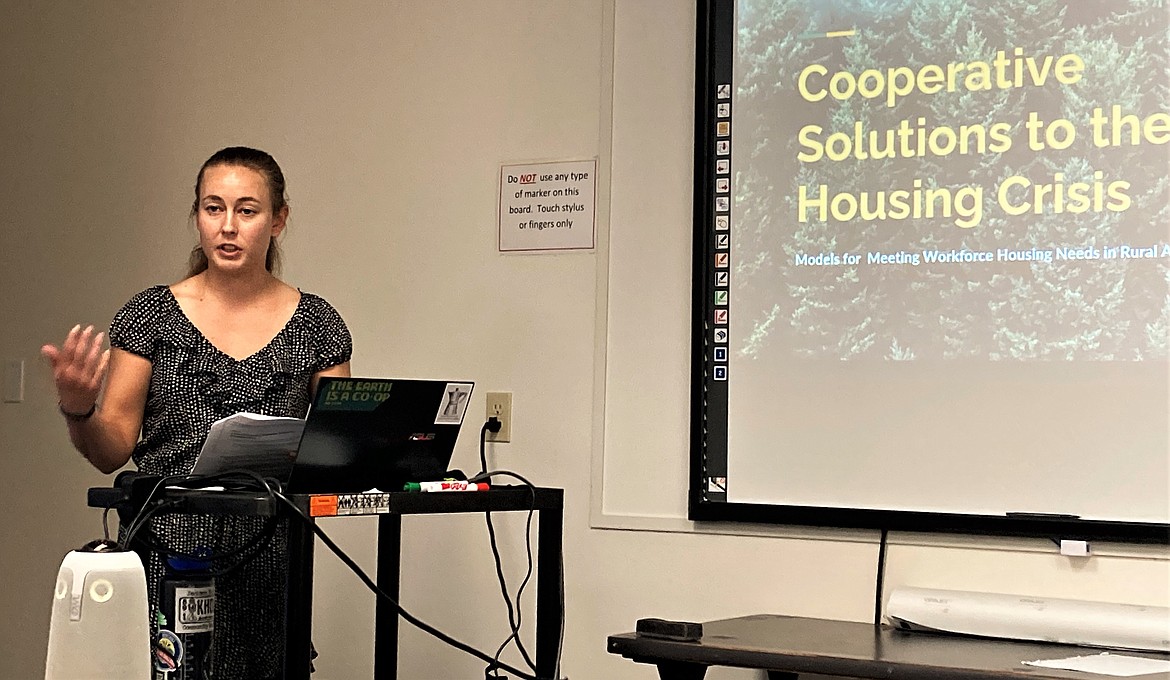Ronan event explores housing co-op models
RONAN — Mission West Community Development Partners and Montana Cooperative Development Center (MCDC) introduced the concept of housing cooperatives in a roundtable discussion Aug. 17 in Ronan.
Presenters Kaylee Thornley, Cooperative Development Center director at Mission West, and Tracy McIntyre of MCDC, said co-ops are one option for communities, businesses, investors, and potential renters and homeowners to work together to address the lack of affordable housing in Lake County and the surrounding region.
Thornley shared 2020 census data that showed Lake, Sanders, Mineral and Missoula counties’ populations grew by about 8% each over the past decade. Flathead County grew by 15%. These numbers do not capture the recent influx of people moving to rural areas for improved quality of life during the pandemic.
“The housing market is not keeping up,” Thornley said.
Thornley explained that a cooperative housing model differs from condominiums, in which individuals own their own units as real estate, not shares in a corporation. With co-ops they share an ownership interest in community property such as common walls and exterior landscaping. Co-ops also differ from rentals, in which the tenant has no ownership, and little say over property management.
In a co-op, she said, “everyone owns a share in the corporation, so everyone owns the property together.”
Each member has one vote in decisions based on what they feel best benefits the entire community, and shares in both expenses and revenue, if any.
A co-op can help fill the “middle rung” of the housing ladder, Thornley said, appealing to people who perhaps do not qualify for or cannot access public housing, but want to gain ownership and equity without having to build or purchase a home on their own, “especially in the current market where houses can be $400,000 or more.”
Thornley gave examples of housing co-op models that exist throughout the U.S. She suggested the employer investment model may be of interest here, in which individuals, businesses and organizations can work together to develop real estate and affordable housing for workers and the community.
Investor members build equity as the value and price of shares appreciates. In a “limited equity” co-op intended to keep housing affordable, the co-op bylaws can direct how much the price of each share can increase, and what maintenance fees are required, keeping units affordable in the long run.
“Co-ops are not new in the state of Montana,” McIntyre explained. MCDC is a statewide economic development organization that uses the cooperative business model to address needs of communities, businesses and individuals, including housing, telecommunications, investment, retail, workers, child care and agriculture.
“You name it, we seem to be working in it right now. Our laws in Montana allow us to do a lot of very creative cooperative development,” McIntyre said. “We’re not small, we’re a major industry, we’re just trying to get that word out.”
Co-ops contribute $7.6 billion to the state’s economy, she said.
McIntyre focused on the Riverside Crossing model, a for-profit entity developed on donated land by a partnership between Ravalli Economic Development and the Council on Aging. Residents buy into a chosen cottage size and design. Prices range from $190,870 to $370,800, plus monthly fees that include access to shared amenities such as a shop, raised garden beds and an outdoor fireplace. As a limited equity co-op, only 1% appreciation on the value of their development is allowed.
Examples of housing co-ops in Montana and elsewhere include Riverside Crossing, a 55-and-older cottage community in Hamilton; Northwood Community, a resident-owned mobile home community in Ronan; Lopez Community Land Trust, a limited equity co-op in the San Juan Islands; and Perennial Co-op, a large home shared by 10 people in Madison, Wisconsin. Monthly costs of $400 at the Perennial site include mortgage payments on the home, utilities, maintenance and shared supplies, compared to $1,300 average rent in the area. Co-op members share in the house labor to keep costs down.
A newer model in Montana, Opportunity Development Co-ops (ODC) are being used to offer investment opportunities for the community in real estate, social enterprises or even revolving loan funds to help businesses with startup or working capital. ODCs spark economic development, create jobs, and much more, while creating a modest income source for member stockholders investing in their community, McIntyre said.
Gardner, Livingston, and other Montana communities are pursuing various types of ODCs for employee housing.
For more information on cooperatives, contact Kaylee Thornley at Mission West at 406-676-5919.


